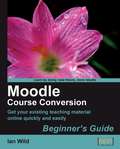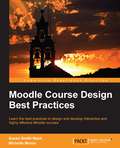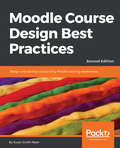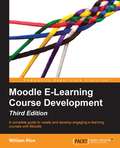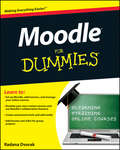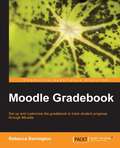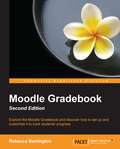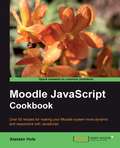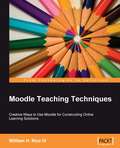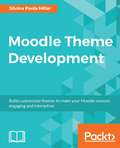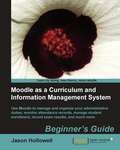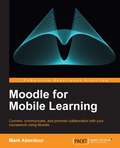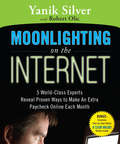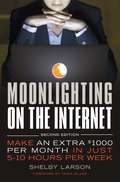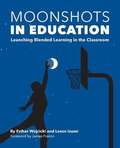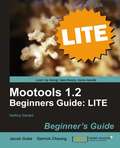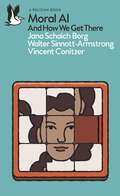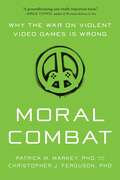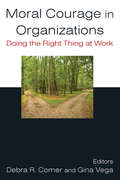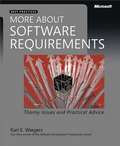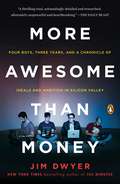- Table View
- List View
Moodle Course Conversion: Beginner's Guide
by Ian WildWith clear instructions and plenty of screenshots, this book provides all the support and guidance you will need as you begin to convert your teaching to Moodle. Step-by-step tutorials use real-world examples to show you how to convert to Moodle in the most efficient and effective ways possible. Moodle Course Conversion carefully illustrates how Moodle can be used to teach content and ideas and clearly demonstrates the advantages of doing so. This book is for teachers, tutors, and lecturers who already have a large body of teaching material and want to use Moodle to enhance their courses, rather than developing brand new ones. You won't need experience with Moodle, but will need teacher access to a ready installed Moodle site. Teachers with some experience of Moodle, who want to focus on incorporating existing course materials will also find this book very useful.
Moodle Course Design Best Practices
by Susan Smith Nash Michelle MooreThis book is an easy-to-follow guide with a hands-on approach that will help you learn the best practices for designing attractive and highly interactive courses with the help of Moodle. This book can be used by training managers, teachers, instructors, Moodle network specialists, instructional designers, and e-learning entrepreneurs. If you are involved in online, cloud-based education, training, or professional development, this is the book for you. No prior experience with Moodle is required, though it would be helpful to understand the basics of using HTML and also working with different multimedia file formats and social media. If you would like to find a very easy and convenient way to organize learning activities along with group projects and activities, then this is the book for you.
Moodle Course Design Best Practices: Design and develop outstanding Moodle learning experiences, 2nd Edition
by Susan Smith NashFast-paced guide for designing effective Moodle courses; experiment with Moodle’s features for free using MoodleCloudKey FeaturesApply principles of instructional design to create great Moodle learning experiencesEnhance collaboration and spur creativity with MoodleBring together instructional materials, social interaction, and student management functions in your coursesBook DescriptionMoodle is a leading virtual learning environment for your online course. This book incorporates the principles of instructional design, showing you how to apply them to your Moodle courses. With this guidance, you will develop and deploy better courses, content, and assessments than ever.This book will guide you as you learn how to build and incorporate many different types of course materials and dynamic activities. You will learn how to improve the structure and presentation of resources, activities, and assessments. All this will help you to create better for self-led courses, instructor-led courses, and courses for collaborative groups. The use of multimedia features to enhance your Moodle courses is also explained in this book.Our goal is to encourage creativity, and the free MoodleCloud hosting option is an ideal place for teachers, students, trainers, and administrators to jump in and play with all the new features, which include powerful new plug-ins, new resources, and activities.Moodle can be your sandbox as well as your castle of learning! With this book, you will build learning experiences that will last your learners’ lifetimes.What you will learnBuild a course structure that fits your goalsDesign a unique appearanceManage the resources and activitiesTips for better organization of your course contentSelect and set up assessmentsInclude effective instructional strategiesIncorporate competency frameworksRun and archive webinarsMotivate learners by incorporating badgesExplore MoodleCloudWho this book is forIf you create courses with Moodle, this book is for you. It can be used by teachers, instructors, training managers, Moodle administrators, instructional technologists, instructional designers, and e-learning entrepreneurs. Prior experience with Moodle will be helpful.
Moodle E-Learning Course Development - Third Edition
by William RiceThis book is for anyone who wants to get the best out of Moodle. Experienced Moodle users will find powerful insights into developing successful educational courses.
Moodle For Dummies
by Radana DvorakThe fun and friendly guide to the world's most popular online learning management systemModular Object Oriented Dynamic Learning Environment, also known as Moodle, is an online learning management system that creates opportunities for rich interaction between educators and their audience. However, the market has been lacking a simple, easy-to-understand guide that covers all the essentials of Moodle?until now. Using straightforward language and an entertaining tone to decipher the intricate world of Moodle, this book provides you with the resources you need to take advantage of all the eLearning and eTraining possibilities that Moodle offers. Offers a hands-on approach to learning Moodle, the revolutionary online learning management systemUses simple language peppered with good humor to break down the complexities of Moodle into easily digested pieces of informationCaters to the specific needs of teachers and business trainers by providing the resources they needMoodle For Dummies provides you with the tools you need to acquire a solid understanding of Moodle and start implementing it in your courses.
Moodle Gradebook
by Rebecca BarringtonA practical book with plenty of step-by-step instructions and informative screenshots to guide you through the many features of gradebook. Moodle Gradebook is for anyone who uses Moodle as a course instructor. You will need to know the basic functions of using and navigating Moodle, but no prior knowledge of the grades functions will be required.
Moodle Gradebook - Second Edition
by Rebecca BarringtonThis book is for teachers and administrators who have experience with Moodle. Basic knowledge of Moodle 2.x will be required, but no prior knowledge of grade functions is needed. This book will help you utilize the full functionality of Version 2.7.
Moodle JavaScript Cookbook
by Alastair HoleThis is a cookbook that contains a list of recipes explaining step-by-step how to use JavaScript in Moodle. The first two chapters concentrate on the basics of how to start working with JavaScript and the YUI while the later chapters show how to use these techniques as a basis for implementing more complete functionality.This book is aimed at developers and administrators comfortable with customizing Moodle with the use of plugin modules, themes, and patches who want to make their site more dynamic. If you have prior knowledge of HTML, PHP, and CSS and a good working knowledge of the underlying structure of Moodle, then this book is for you. No prior experience with JavaScript is needed.
Moodle Security
by Darko MiletiMoodle Security is packed with practical examples, which guide you through optimizing the protection of your Moodle site. Each chapter covers a different security threat and how to secure your site against it. You will also find recommendations for what is best for your particular system and usage. If you are in charge of Moodle - whether you are an administrator or lead teacher - then securing it is one of the most important things that you can do. You need to know the basics of working with Moodle, but no previous experience of system administration is required.
Moodle Teaching Techniques
by William RiceThis book has a friendly approach and even experienced trainers will benefit a lot from it. It uses copious screenshots, for you to get a feel of the course site even while you are learning by building the solutions. If you are a teacher or a corporate trainer with a desire to design effective and innovative Moodle courses, then this book is your best choice. The book assumes that you have a basic understanding of Moodle, but it does not need any programming knowledge. It's all about teaching and not programming. If you are new to Moodle, start with Moodle E-Learning Course Development by the same author.
Moodle Theme Development
by Silvina Paola HillarBuild customized themes to make your Moodle courses engaging and interactive About This Book * Leverage the power of Moodle 3 to create interactive and engaging themes for your courses * Experience and integrate the power of Bootstrap and CSS into your Moodle app * Implement your plans with illustrative examples to become a top notch designer Who This Book Is For If you are a Moodle administrator, developer, or designer and wish to enhance your Moodle site to make it visually attractive, then this book is for you. You should be familiar with web design techniques such as HTML and further experience with CSS would be helpful. What You Will Learn * Plan a personalized Moodle theme from start to finish * Install a Moodle theme in different operating systems and change Moodle's theme settings * Add your own customized logo and test your changes in several web browsers * Customize the Moodle site to fit in with other elements such as websites and social networks, among others * Create a design mock-up using graphics software * Design themes that are capable of working with a huge number of different resolutions, screen sizes, screen orientations, and pixel densities * Work with code to adjust the theme to users requirements * Create new custom icons for your theme In Detail Theming is one of the main features of Moodle, and it can be used to customize your online courses and make them look exactly how you want them to,according to your target audience. If you have been looking for a book that will help you develop Moodle themes that you are proud of, and that your students will enjoy, then this is the book for you. We start off by introducing Moodle 3 and explaining what it is, how it works, and what tools you might need to create a stunning Moodle theme. We then show you how to choose and change the pre-installed Moodle themes in detailed steps, and explain what Moodle themes are and how they work. Next, we show you how to change an existing theme and test the changes that you have made. You can not only plan the customization of theme, but also tailor it using advanced Moodle theming processes; this book is your one-stop guide to creating your own personalized Moodle 3 theme. Style and approach This book acts as a comprehensive guide which helps you to create visually stunning and responsive themes to add that extra edge to your Moodle apps.
Moodle as a Curriculum and Information Management System
by Jason HollowellThis book is a beginner's guide in which the reader is led, step-by-step, to accomplish all the tasks right from installing Moodle to transforming into a CMS. Some more advanced steps and concepts are presented but always in a manner that allows beginners to follow along and learn through experience as they experiment on their own test site. By the time you finish the book, you will have your own fully-functional curriculum and information management system.If you are a teacher or head of department in an institution and are interested in how Moodle can be used to streamline curriculum delivery and information flow in your institution, this book is for you. This book is also useful for Moodle administrators.Prior experience with Moodle is not essential for this book.
Moodle for Mobile Learning
by Mark AberdourA guide with practical examples that gives you hands-on knowledge in creating learning environments for Mobile devices using Moodle, while also empowering you to create your own effective mlearning course designs."Moodle for Mobile Learning" is primarily aimed at Moodle course practitioners - teachers, tutors, instructors, and learning and development professionals. It does not require you to have an in-depth knowledge about any mobile technologies. It is for anyone who has the desire to deliver great courses that allow their learners to interact using the devices in their pockets.
Moodle-1.9-multimedia
by João Pedro FernandesThe book is written in a tutorial style where you work through examples that describe how you can create multimedia applications using Moodle and integrate your existing multimedia resources into your Moodle course. It also tells you how to use multimedia effectively giving ideas and best practices. The book is primarily aimed at teachers and trainers who run professional courses and have experience in the use of Moodle. At the same time, it is not necessary to have an advanced technical background to create multimedia elements, as the tasks will be simple and as little time consuming as possible, relevant to everyday use.
Moonlighting on the Internet
by Yanik SilverInternet marketing guru Yanik Silver has scoured the internet to bring together 5 world-class experts who make thousands in extra cash online each month. They reveal their secrets to making unlimited cash using today's hottest online moneymaking methods: selling information, eBay, affiliate marketing, Yahoo! Stores and blogging.
Moonlighting on the Internet: Make An Extra $1000 Per Month in Just 5-10 Hours Per Week
by Yanik Silver Shelby LarsonMAKE AN EXTRA $1000 PER MONTH IN JUST 5-10 HOURS PER WEEKMoonlighting on the Internet presents the most reliable and proven ways to create extra income for the short term and establish a continual revenue stream for the long term -- giving consideration to your time and lifestyle needs. Internet entrepreneur Shelby Larson does not encourage you to "make money from home in your underwear," or present "the magic-bullet plan to making millions." Instead, Larson shows you how to: Assess your skills, resources, and goals Evaluate the right profit path for you Find clients, create proposals, manage projects, and set rates Market your website using smart, high-quality content that ranks well Generate traffic using display ads, retargeting, and other traffic drivers Distribute content using social media, Q&A sites, and forums Create sales funnels using proven traffic strategies and tactics
Moonshots in Education: Launching Blended Learning in the Classroom
by Esther Wojcicki Lance T. Izumi Alicia Chang Alex Silverman Elliott ParisiThis book explores blended and project based learning in which online learning is used in conjunction with classroom learning with several models and examples of schools that are already implementing digital learning and what the success rate has been.
Mootools 1.2 Beginners Guide LITE: Getting started
by Jacob GubeThis is a Packt Beginner's Guide, which means it is packed with clear step-by-step instructions for performing the most useful tasks in MooTools. You will learn by doing and you will start learning immediately. This book is perfect for MooTools newcomers. You do not require any familiarity with MooTools whatsoever, only a willingness to learn. Basic knowledge of JavaScript syntax and concepts is the only requirement. This book will allow you to grasp the basics of MooTools so that you will be well on the way to creating exciting, customizable web pages and applications.
Moral AI: And How We Get There (Pelican Books)
by Walter Sinnott-Armstrong Jana Schaich Borg Vincent ConitzerA balanced and thought-provoking guide to all the big questions about AI and ethics Can computers understand morality? Can they respect privacy? And what can we do to make AI safe and fair? The artificial intelligence revolution has begun. Today, there are self-driving cars on our streets, autonomous weapons in our armies, robot surgeons in our hospitals – and AI's presence in our lives will only increase. Some see this as the dawn of a new era in innovation and ease; others are alarmed by its destructive potential. But one thing is clear: this is a technology like no other, one that raises profound questions about the very definitions of human intelligence and morality. In Moral AI, world-renowned researchers in moral psychology, philosophy, and artificial intelligence – Jana Schaich Borg, Walter Sinnott-Armstrong and Vincent Conitzer – tackle these thorny issues head-on. Writing lucidly and calmly, they lay out the recent advances in this still nascent field, peeling away the exaggeration and misleading arguments. Instead, they offer clear examinations of the moral concerns at the heart of AI programs, from racial equity to personal privacy, fake news to autonomous weaponry. Ultimately, they argue that artificial intelligence can be built and used safely and ethically, but that its potential cannot be achieved without careful reflection on the values we wish to imbue it with. This is an essential primer for any thinking person.
Moral Combat: Why the War on Violent Video Games Is Wrong
by Christopher J. Ferguson Patrick M. MarkeyIn family rooms across America, millions of children and teenagers are playing video games, such as Call of Duty, Halo, and Grand Theft Auto, roaming violent virtual worlds—with virtual guns in their hands. In what sometimes seems like an increasingly violent world, it's only natural to worry about the effects of all this pixelated gore. But is that concern misplaced? Authors and psychologists Patrick M. Markey and Christopher J. Ferguson say it is. The media and politicians have been sounding the alarm for years, and with every fresh tragedy involving a young perpetrator comes another flurry of articles about the dangers of violent media. The problem is this: Their fear isn't supported by the evidence. In fact, unlike the video game–trained murder machines depicted in the press, school shooters are actually less likely to be interested in violent games than their peers. In reality, most well-adjusted children and teenagers play violent video games, all without ever exhibiting violent behavior in real life. What's more, spikes in sales of violent games actually correspond to decreased rates of violent crime. If that surprises you, you're not alone—the national dialogue on games and violence has been hopelessly biased. But that's beginning to change. Scholars are finding that not only are violent games not one of society's great evils, they may even be a force for good. In Moral Combat, Markey and Ferguson explore how video games—even the bloodiest—can have a positive impact on everything from social skills to stress, and may even make us more morally sensitive. Tracing the rise of violent games from arcades to online deathmatches, they have spent years on the front lines of the video game debate and now offer a comprehensive overview of the scientific research on gaming. With humor, complete honesty, and extensive research, they separate the myth from the medium. Moral Combat is an irreverent and informative guide to the worries—and wonders—of our violent virtual world.
Moral Courage in Organizations: Doing the Right Thing at Work
by Gina Vega Debra R. ComerThe topic of moral courage is typically missing from business ethics instruction and management training. But moral courage is what we need when workplace pressures threaten to compromise our values and principles. Moral Courage in Organizations: Doing the Right Thing at Work, edited by Debra Comer and Gina Vega, underscores for readers the ethical pitfalls they can expect to encounter at work and enhances their ability do what they know is right, despite these organizational pressures. The book highlights the effects of organizational factors on ethical behavior; illustrates exemplary moral courage and lapses of moral courage; explores the skills and information that support those who act with moral courage; and considers how to change organizations to promote moral courage, as well as how to exercise moral courage to change organizations. By giving readers who want to do the right thing guidelines for going about it, Moral Courage in Organizations: Doing the Right Thing at Work is a potent tool to foster more ethical organizational behavior.
Moral und künstliche Intelligenz im Marketing (Beiträge zur empirischen Marketing- und Vertriebsforschung)
by Robin PadeKonsumentendaten lassen sich zunehmend effektiv mit künstlicher Intelligenz (KI) kombinieren, um die Online Journey kalkuliert zu beeinflussen. Dieses Buch befasst sich anhand dreier Forschungsarbeiten mit den Fragen wann Marketing-KI Konsumentenentscheidungen vielmehr manipuliert als bereichert und wie Marketing-KI infolgedessen moralischer gestaltet werden kann. Die erste Forschungsarbeit untersucht, inwieweit Manipulationswahrnehmungen vom Menschenbild des Konsumenten abhängen. Hierfür werden zwei Studien mit 1.151 Teilnehmern durchgeführt. Daran anknüpfend stellt sich die Frage, ob Manager Konsumentenbilder auf opportunistische Weise instrumentalisieren, um Marketingaktivitäten zu legitimieren. Die zweite Forschungsarbeit kombiniert daher Methoden der Ökonometrie und des Natural Language Processing, um Menschenbilder von Managern aus Textdaten (33.407 Earnings Call Transkripte) zu analysieren. Die dritte Forschungsarbeit möchte Marketing-KI moralischer gestalten. Hierfür werden neuronale Netze mithilfe psychografischer Daten von 762 Teilnehmern trainiert, um faire personalisierte Preise anzubieten und Reaktionen mittels Laborexperiment (203 Probanden) zu untersuchen.
More About Software Requirements: Thorny Issues and Practical Advice
by Karl E. Wiegers<div xmlns="http://www.w3.org/1999/xhtml"><p>A must-have for software developers and architects, this brief follow-up to the bestselling Software Requirements, Second Edition, gives practical, proven, real-world techniques for gathering and managing software requirements.</p></div>
More About Software Requirements: Thorny Issues and Practical Advice
by Karl Wiegers<div xmlns="http://www.w3.org/1999/xhtml"><p>A must-have for software developers and architects, this brief follow-up to the bestselling Software Requirements, Second Edition, gives practical, proven, real-world techniques for gathering and managing software requirements.</p></div>
More Awesome Than Money
by Jim DwyerDavid versus Goliath in Silicon Valley--an epic attempt to take back the Internet Their idea was simple. Four NYU undergrads wanted to build a social network that would allow users to control their personal data, instead of surrendering it to big businesses like Facebook. They called it Diaspora. In days, they raised $200,000, and reporters, venture capitalists, and the digital community's most legendary figures were soon monitoring their progress. Max dreamed of being a CEO. Ilya was the idealist. Dan coded like a pro, and Rafi tried to keep them all on track. But as the months passed and the money ran out, the Diaspora Four fell victim to errors, bad decisions, and their own hubris. In November 2011, Ilya committed suicide. Diaspora has been tech news since day one, but the story reaches far beyond Silicon Valley to the now urgent issues about the future of the Internet. With the cooperation of the surviving partners, New York Times bestselling author Jim Dwyer tells a riveting story of four ambitious and naÏve young men who tried to rebottle the genie of personal privacy--and paid the ultimate price.
